Report: Gibbs Reflective Cycle Analysis of Student Engagement
VerifiedAdded on 2020/06/04
|5
|1097
|44
Report
AI Summary
This report utilizes the Gibbs Reflective Cycle to analyze student engagement and identify factors affecting effective results in academic settings. The report details the application of the cycle, encompassing stages of description, feelings, evaluation, conclusion, and action. The student explored the student's perspective on project development by asking questions and analyzing their interest and contribution. The analysis reveals that some students are highly engaged, some have theoretical knowledge but struggle with practical application, and some lack both. The report proposes actions to increase participation, such as explaining project importance, providing incentives, and encouraging innovative approaches. The report concludes with a comprehensive list of references, including books and journals related to academic skills and student engagement. The report provides insights into enhancing student involvement and improving learning outcomes.
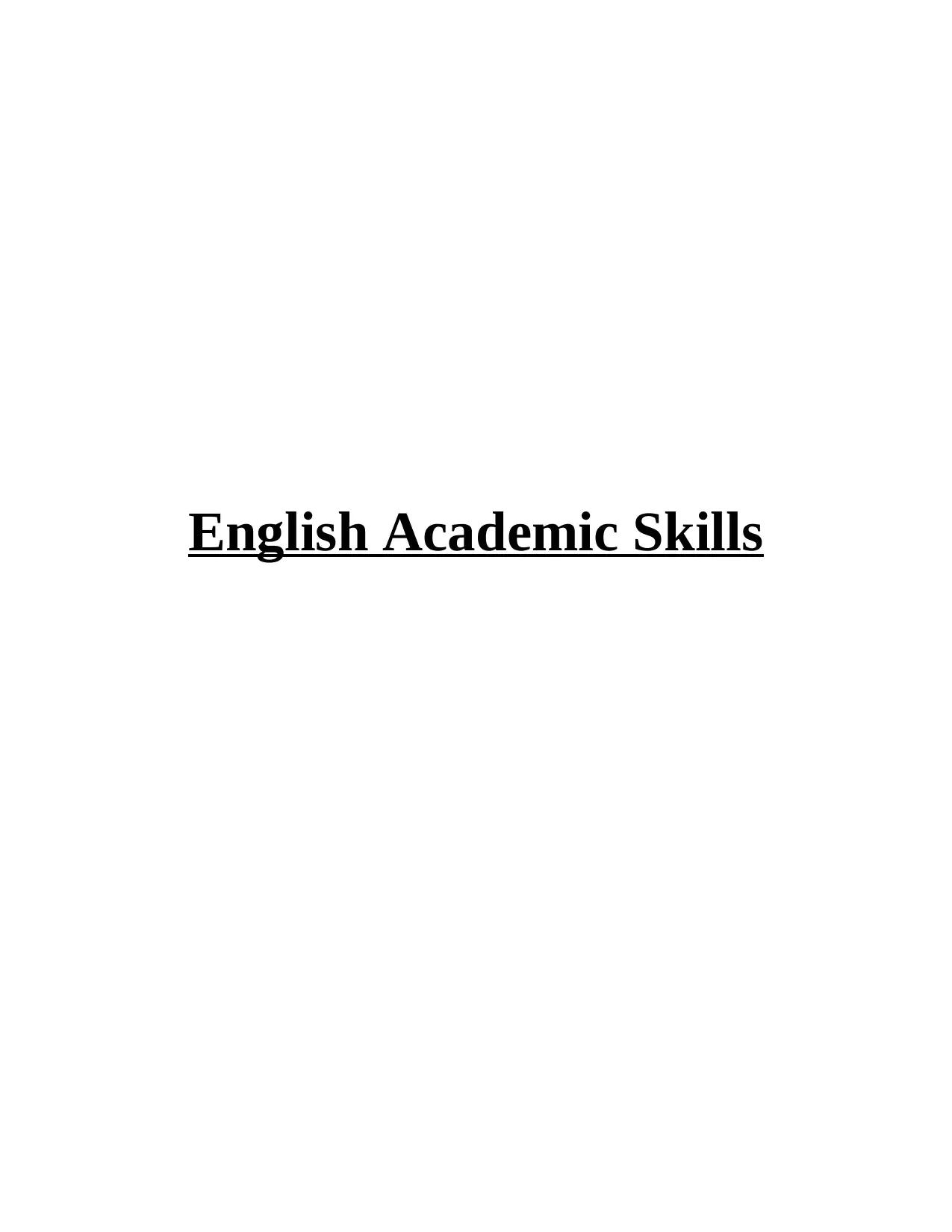
English Academic Skills
Paraphrase This Document
Need a fresh take? Get an instant paraphrase of this document with our AI Paraphraser
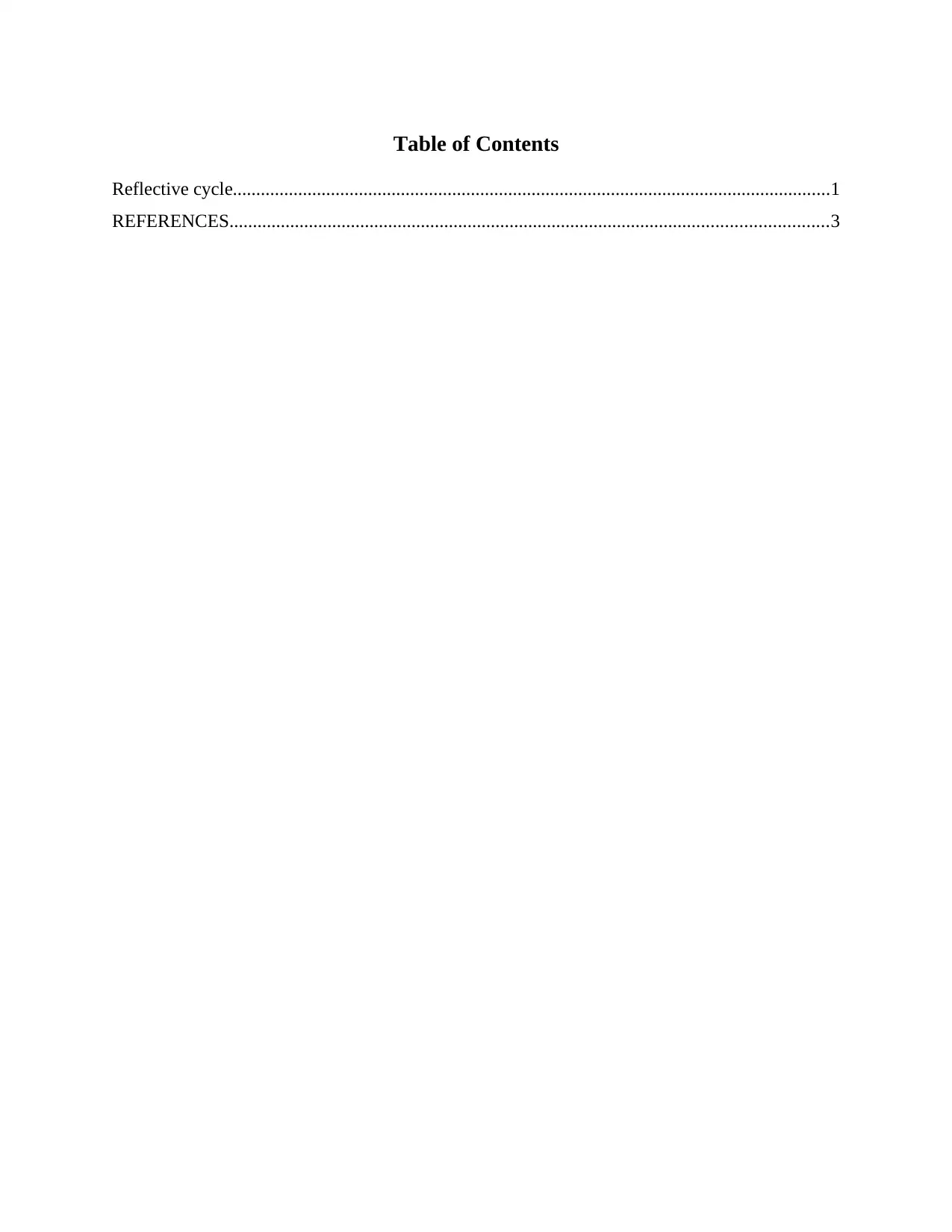
Table of Contents
Reflective cycle................................................................................................................................1
REFERENCES................................................................................................................................3
Reflective cycle................................................................................................................................1
REFERENCES................................................................................................................................3
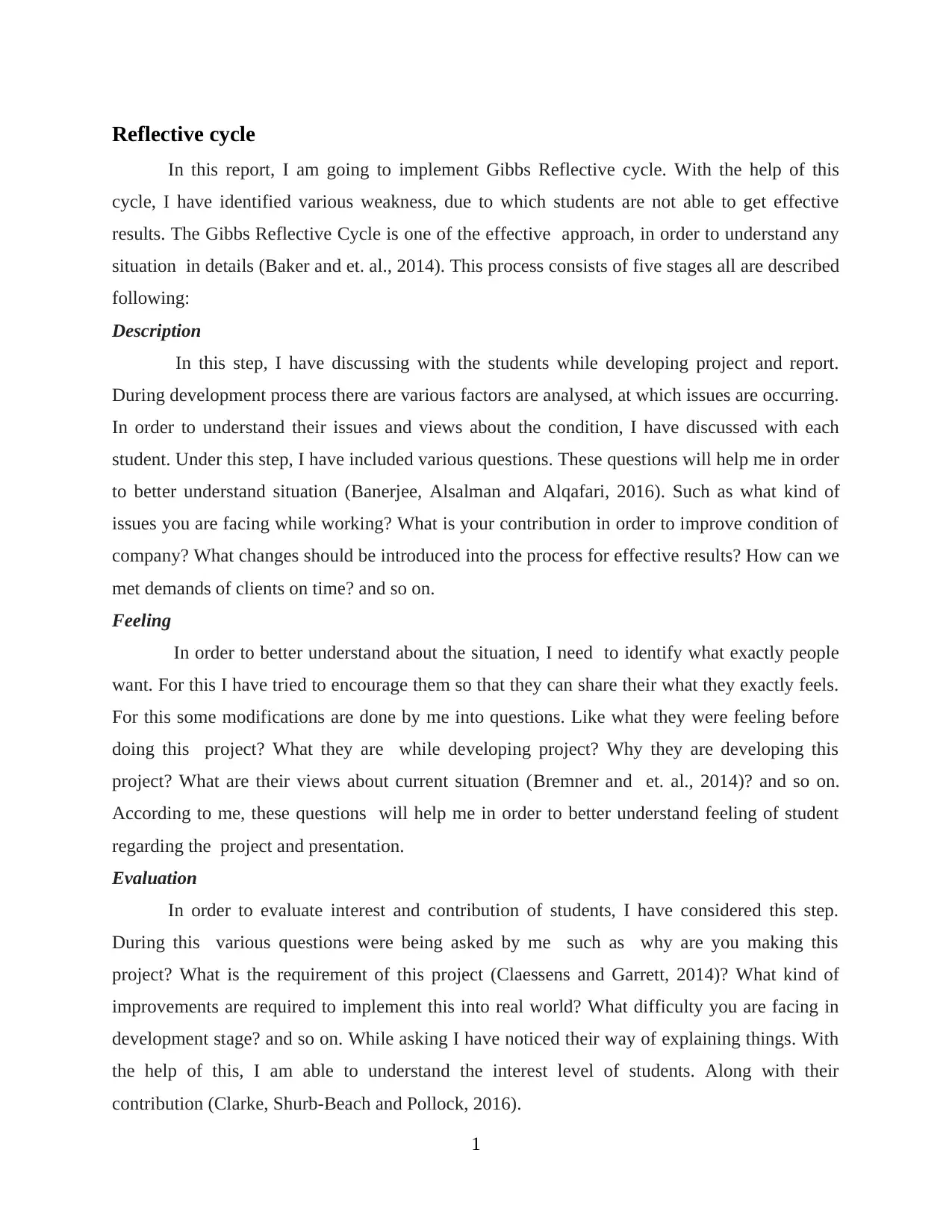
Reflective cycle
In this report, I am going to implement Gibbs Reflective cycle. With the help of this
cycle, I have identified various weakness, due to which students are not able to get effective
results. The Gibbs Reflective Cycle is one of the effective approach, in order to understand any
situation in details (Baker and et. al., 2014). This process consists of five stages all are described
following:
Description
In this step, I have discussing with the students while developing project and report.
During development process there are various factors are analysed, at which issues are occurring.
In order to understand their issues and views about the condition, I have discussed with each
student. Under this step, I have included various questions. These questions will help me in order
to better understand situation (Banerjee, Alsalman and Alqafari, 2016). Such as what kind of
issues you are facing while working? What is your contribution in order to improve condition of
company? What changes should be introduced into the process for effective results? How can we
met demands of clients on time? and so on.
Feeling
In order to better understand about the situation, I need to identify what exactly people
want. For this I have tried to encourage them so that they can share their what they exactly feels.
For this some modifications are done by me into questions. Like what they were feeling before
doing this project? What they are while developing project? Why they are developing this
project? What are their views about current situation (Bremner and et. al., 2014)? and so on.
According to me, these questions will help me in order to better understand feeling of student
regarding the project and presentation.
Evaluation
In order to evaluate interest and contribution of students, I have considered this step.
During this various questions were being asked by me such as why are you making this
project? What is the requirement of this project (Claessens and Garrett, 2014)? What kind of
improvements are required to implement this into real world? What difficulty you are facing in
development stage? and so on. While asking I have noticed their way of explaining things. With
the help of this, I am able to understand the interest level of students. Along with their
contribution (Clarke, Shurb-Beach and Pollock, 2016).
1
In this report, I am going to implement Gibbs Reflective cycle. With the help of this
cycle, I have identified various weakness, due to which students are not able to get effective
results. The Gibbs Reflective Cycle is one of the effective approach, in order to understand any
situation in details (Baker and et. al., 2014). This process consists of five stages all are described
following:
Description
In this step, I have discussing with the students while developing project and report.
During development process there are various factors are analysed, at which issues are occurring.
In order to understand their issues and views about the condition, I have discussed with each
student. Under this step, I have included various questions. These questions will help me in order
to better understand situation (Banerjee, Alsalman and Alqafari, 2016). Such as what kind of
issues you are facing while working? What is your contribution in order to improve condition of
company? What changes should be introduced into the process for effective results? How can we
met demands of clients on time? and so on.
Feeling
In order to better understand about the situation, I need to identify what exactly people
want. For this I have tried to encourage them so that they can share their what they exactly feels.
For this some modifications are done by me into questions. Like what they were feeling before
doing this project? What they are while developing project? Why they are developing this
project? What are their views about current situation (Bremner and et. al., 2014)? and so on.
According to me, these questions will help me in order to better understand feeling of student
regarding the project and presentation.
Evaluation
In order to evaluate interest and contribution of students, I have considered this step.
During this various questions were being asked by me such as why are you making this
project? What is the requirement of this project (Claessens and Garrett, 2014)? What kind of
improvements are required to implement this into real world? What difficulty you are facing in
development stage? and so on. While asking I have noticed their way of explaining things. With
the help of this, I am able to understand the interest level of students. Along with their
contribution (Clarke, Shurb-Beach and Pollock, 2016).
1
⊘ This is a preview!⊘
Do you want full access?
Subscribe today to unlock all pages.

Trusted by 1+ million students worldwide
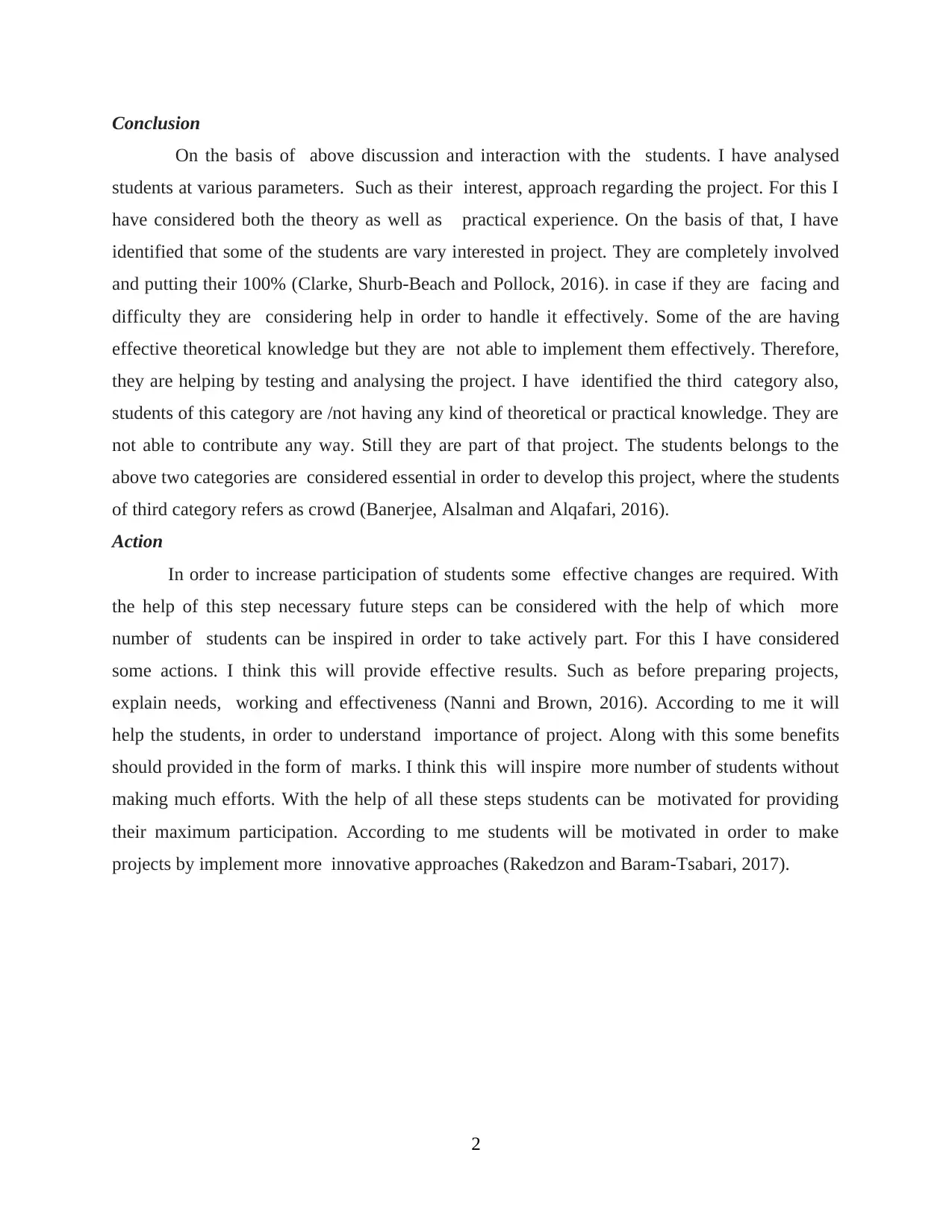
Conclusion
On the basis of above discussion and interaction with the students. I have analysed
students at various parameters. Such as their interest, approach regarding the project. For this I
have considered both the theory as well as practical experience. On the basis of that, I have
identified that some of the students are vary interested in project. They are completely involved
and putting their 100% (Clarke, Shurb-Beach and Pollock, 2016). in case if they are facing and
difficulty they are considering help in order to handle it effectively. Some of the are having
effective theoretical knowledge but they are not able to implement them effectively. Therefore,
they are helping by testing and analysing the project. I have identified the third category also,
students of this category are /not having any kind of theoretical or practical knowledge. They are
not able to contribute any way. Still they are part of that project. The students belongs to the
above two categories are considered essential in order to develop this project, where the students
of third category refers as crowd (Banerjee, Alsalman and Alqafari, 2016).
Action
In order to increase participation of students some effective changes are required. With
the help of this step necessary future steps can be considered with the help of which more
number of students can be inspired in order to take actively part. For this I have considered
some actions. I think this will provide effective results. Such as before preparing projects,
explain needs, working and effectiveness (Nanni and Brown, 2016). According to me it will
help the students, in order to understand importance of project. Along with this some benefits
should provided in the form of marks. I think this will inspire more number of students without
making much efforts. With the help of all these steps students can be motivated for providing
their maximum participation. According to me students will be motivated in order to make
projects by implement more innovative approaches (Rakedzon and Baram-Tsabari, 2017).
2
On the basis of above discussion and interaction with the students. I have analysed
students at various parameters. Such as their interest, approach regarding the project. For this I
have considered both the theory as well as practical experience. On the basis of that, I have
identified that some of the students are vary interested in project. They are completely involved
and putting their 100% (Clarke, Shurb-Beach and Pollock, 2016). in case if they are facing and
difficulty they are considering help in order to handle it effectively. Some of the are having
effective theoretical knowledge but they are not able to implement them effectively. Therefore,
they are helping by testing and analysing the project. I have identified the third category also,
students of this category are /not having any kind of theoretical or practical knowledge. They are
not able to contribute any way. Still they are part of that project. The students belongs to the
above two categories are considered essential in order to develop this project, where the students
of third category refers as crowd (Banerjee, Alsalman and Alqafari, 2016).
Action
In order to increase participation of students some effective changes are required. With
the help of this step necessary future steps can be considered with the help of which more
number of students can be inspired in order to take actively part. For this I have considered
some actions. I think this will provide effective results. Such as before preparing projects,
explain needs, working and effectiveness (Nanni and Brown, 2016). According to me it will
help the students, in order to understand importance of project. Along with this some benefits
should provided in the form of marks. I think this will inspire more number of students without
making much efforts. With the help of all these steps students can be motivated for providing
their maximum participation. According to me students will be motivated in order to make
projects by implement more innovative approaches (Rakedzon and Baram-Tsabari, 2017).
2
Paraphrase This Document
Need a fresh take? Get an instant paraphrase of this document with our AI Paraphraser
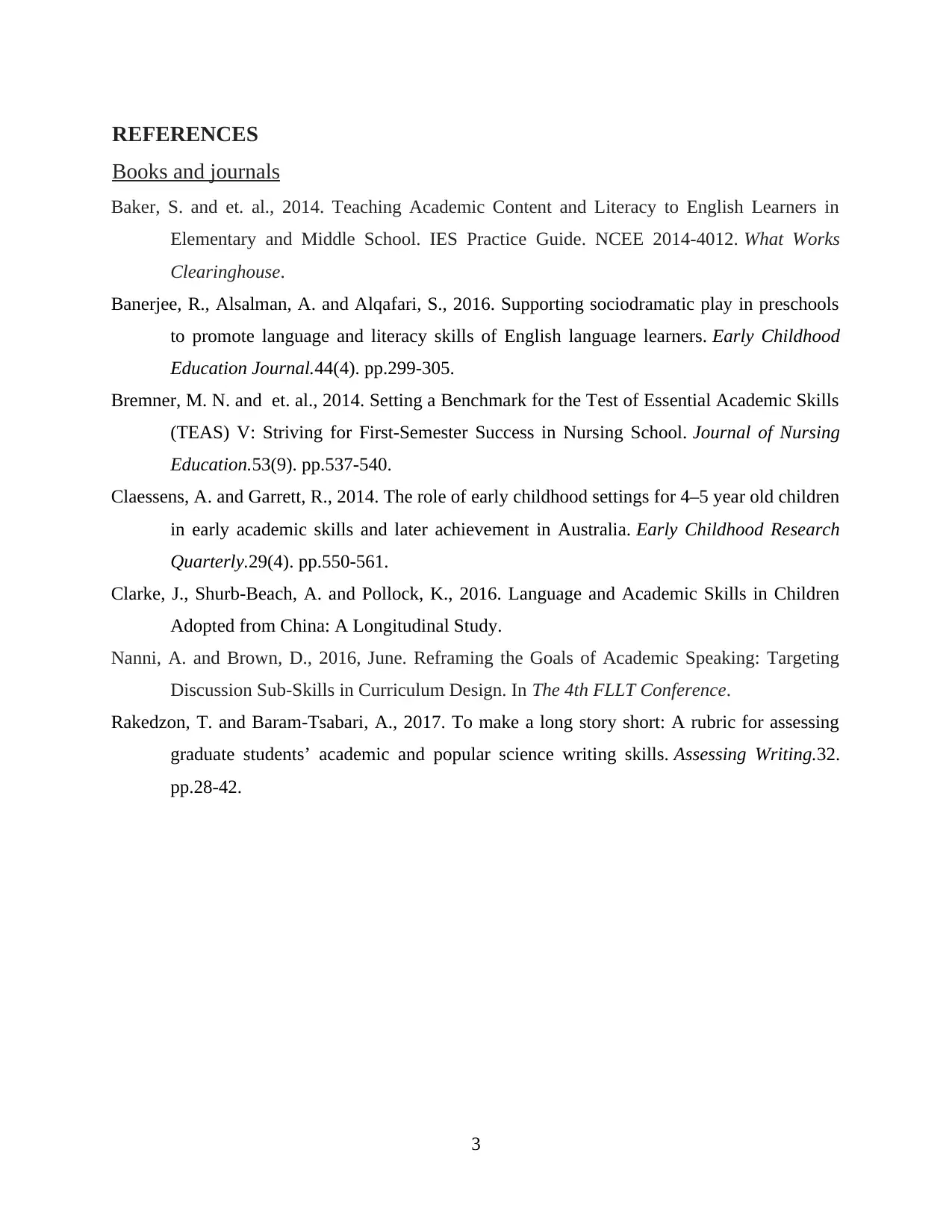
REFERENCES
Books and journals
Baker, S. and et. al., 2014. Teaching Academic Content and Literacy to English Learners in
Elementary and Middle School. IES Practice Guide. NCEE 2014-4012. What Works
Clearinghouse.
Banerjee, R., Alsalman, A. and Alqafari, S., 2016. Supporting sociodramatic play in preschools
to promote language and literacy skills of English language learners. Early Childhood
Education Journal.44(4). pp.299-305.
Bremner, M. N. and et. al., 2014. Setting a Benchmark for the Test of Essential Academic Skills
(TEAS) V: Striving for First-Semester Success in Nursing School. Journal of Nursing
Education.53(9). pp.537-540.
Claessens, A. and Garrett, R., 2014. The role of early childhood settings for 4–5 year old children
in early academic skills and later achievement in Australia. Early Childhood Research
Quarterly.29(4). pp.550-561.
Clarke, J., Shurb-Beach, A. and Pollock, K., 2016. Language and Academic Skills in Children
Adopted from China: A Longitudinal Study.
Nanni, A. and Brown, D., 2016, June. Reframing the Goals of Academic Speaking: Targeting
Discussion Sub-Skills in Curriculum Design. In The 4th FLLT Conference.
Rakedzon, T. and Baram-Tsabari, A., 2017. To make a long story short: A rubric for assessing
graduate students’ academic and popular science writing skills. Assessing Writing.32.
pp.28-42.
3
Books and journals
Baker, S. and et. al., 2014. Teaching Academic Content and Literacy to English Learners in
Elementary and Middle School. IES Practice Guide. NCEE 2014-4012. What Works
Clearinghouse.
Banerjee, R., Alsalman, A. and Alqafari, S., 2016. Supporting sociodramatic play in preschools
to promote language and literacy skills of English language learners. Early Childhood
Education Journal.44(4). pp.299-305.
Bremner, M. N. and et. al., 2014. Setting a Benchmark for the Test of Essential Academic Skills
(TEAS) V: Striving for First-Semester Success in Nursing School. Journal of Nursing
Education.53(9). pp.537-540.
Claessens, A. and Garrett, R., 2014. The role of early childhood settings for 4–5 year old children
in early academic skills and later achievement in Australia. Early Childhood Research
Quarterly.29(4). pp.550-561.
Clarke, J., Shurb-Beach, A. and Pollock, K., 2016. Language and Academic Skills in Children
Adopted from China: A Longitudinal Study.
Nanni, A. and Brown, D., 2016, June. Reframing the Goals of Academic Speaking: Targeting
Discussion Sub-Skills in Curriculum Design. In The 4th FLLT Conference.
Rakedzon, T. and Baram-Tsabari, A., 2017. To make a long story short: A rubric for assessing
graduate students’ academic and popular science writing skills. Assessing Writing.32.
pp.28-42.
3
1 out of 5
Related Documents
Your All-in-One AI-Powered Toolkit for Academic Success.
+13062052269
info@desklib.com
Available 24*7 on WhatsApp / Email
![[object Object]](/_next/static/media/star-bottom.7253800d.svg)
Unlock your academic potential
Copyright © 2020–2025 A2Z Services. All Rights Reserved. Developed and managed by ZUCOL.




